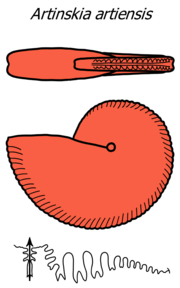Biology:Medlicottioidea
| Medlicottioidea | |
|---|---|

| |
| Artinskia, an Artinskian medlicottiid | |
| Scientific classification | |
| Domain: | Eukaryota |
| Kingdom: | Animalia |
| Phylum: | Mollusca |
| Class: | Cephalopoda |
| Subclass: | †Ammonoidea |
| Order: | †Prolecanitida |
| Superfamily: | †Medlicottioidea |
| Families | |
| |
| Synonyms | |
|
Medlicottiaceae | |
The Medlicottioidea is one of two superfamilies that make up the Prolecanitida, the other being the Prolecanitoidea.
The Medlicottioidea are recognized by their discoidal to thinly lenticular, and involute shells with small umbilici; flat, often grooved venters, and variably complex sutures. Medlicottiacean shells are often more ornamented and may sport ventrolateral nodes or ribs.
The Medlicottioidea combines two related families, the ancestral Pronoritidae, descended from the Prolecanitidae in the Upper Mississippian and the derived Medlicottiidae which first appeared in the Lower Pennsylvanian. A third family, the Sageceratidae, considered to be derived from the Medlicottiidae, is included in the Ceratitida in more recent classifications.
The Medlicottiaceae have become known by the alternative Medlicottiodea, following the recent ruling by the ICZN regarding superfamily endings. Medlicottiaceae nevertheless has a long standing in the literature with the taxonomic rank clear, without the need for explanation.[original research?][citation needed]
References
- Miller, Furnish, and Schindewolf, 1957; Paleozoic Ammonoidea, esp superfamily Medlicottiaceae, L71, in The Treatise on Invertebrate Paleontology, Part L, Ammonoidea.
- Saunders and Work; Abstract: Evolution of shell morphology and suture complexity in Paleozoic prolecanitids..... [1]
Wikidata ☰ Q6807231 entry
 |


